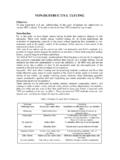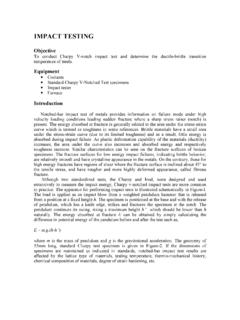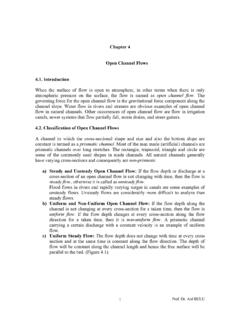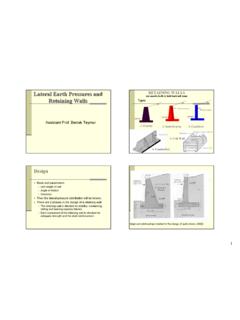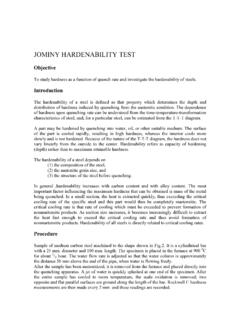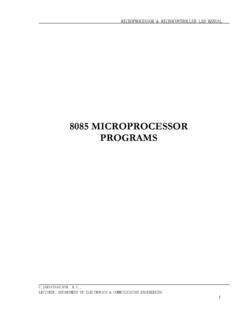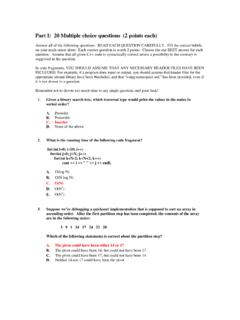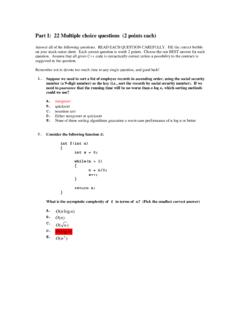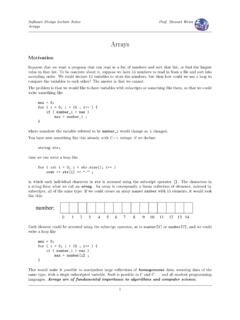Transcription of Cheat sheet Numpy Python copy - Anasayfa
1 2 Python For Data Science Cheat SheetNumPy BasicsLearn Python for Data Science Interactively at Python for Data Science InteractivelyThe Numpy library is the core library for scientific computing in Python . It provides a high-performance multidimensional array object, and tools for working with these arrays. >>> import Numpy as npUse the following import convention:Creating Arrays>>> ((3,4)) Create an array of zeros>>> ((2,3,4),dtype= ) Create an array of ones>>> d = (10,25,5) Create an array of evenly spaced values (step value) >>> (0,2,9) Create an array of evenly spaced values (number of samples)>>> e = ((2,2),7) Create a constant array >>> f = (2) Create a 2X2 identity matrix>>> ((2,2)) Create an array with random values>>> ((3,2))
2 Create an empty arrayArray Mathematics>>> g = a - b Subtraction array ([[ , 0. , 0. ], [-3. , -3. , -3. ]])>>> (a,b) Subtraction>>> b + a Addition array ([[ , 4. , 6. ], [ 5. , 7. , 9. ]])>>> (b,a) Addition>>> a / b Division array ([[ , 1. , 1. ], [ , , ]])>>> (a,b) Division>>> a * b Multiplication array ([[ , 4.)]]
3 , 9. ], [ 4. , 10. , 18. ]])>>> (a,b) Multiplication>>> (b) Exponentiation>>> (b) Square root>>> (a) Print sines of an array >>> (b) Element-wise cosine >>> (a) Element-wise natural logarithm >>> (f) Dot product array ([[ 7., 7.], [ 7., 7.]])Subsetting, Slicing, Indexing>>> () array -wise sum>>> () array -wise minimum value >>> (axis=0) Maximum value of an array row>>> (axis=1) Cumulative sum of the elements>>> () Mean>>> () Median>>> () Correlation coefficient>>> (b) Standard deviationComparison>>> a == b Element-wise comparison array ([[False, True, True], [False, False, False]], dtype=bool)
4 >>> a < 2 Element-wise comparison array ([True, False, False], dtype=bool)>>> (a, b) array -wise comparison1 231D array 2D array 3D 234 56 array ManipulationNumPy Arraysaxis 0axis 1axis 0axis 1axis 2 Arithmetic Operations Transposing array >>> i = (b) Permute array dimensions>>> Permute array dimensions Changing array Shape>>> () Flatten the array >>> (3,-2) Reshape, but don t change data Adding/Removing Elements>>> ((2,6)) Return a new array with shape (2,6) >>> (h,g) Append items to an array >>> (a, 1, 5) Insert items in an array >>> (a,[1]) Delete items from an array Combining Arrays>>> ((a,d),axis=0) Concatenate arrays array ([ 1, 2, 3, 10, 15, 20])>>> ((a,b)) Stack arrays vertically (row-wise) array ([[ 1.)]]
5 , 2. , 3. ], [ , 2. , 3. ], [ 4. , 5. , 6. ]])>>> [e,f] Stack arrays vertically (row-wise)>>> ((e,f)) Stack arrays horizontally (column-wise) array ([[ 7., 7., 1., 0.], [ 7., 7., 0., 1.]])>>> ((a,d)) Create stacked column-wise arrays array ([[ 1, 10], [ 2, 15], [ 3, 20]])>>> [a,d] Create stacked column-wise arrays Splitting Arrays>>> (a,3) Split the array horizontally at the 3rd [ array ([1]), array ([2]), array ([3])] index>>> (c,2) Split the array vertically at the 2nd index[ array ([[[ , 2.]]
6 , 1. ], [ 4. , 5. , 6. ]]]), array ([[[ 3., 2., 3.], [ 4., 5., 6.]]])]Also see Lists Subsetting>>> a[2] Select the element at the 2nd index 3>>> b[1,2] Select the element at row 1 column 2 ( equivalent to b[1][2]) Slicing>>> a[0:2] Select items at index 0 and 1 array ([1, 2])>>> b[0:2,1] Select items at rows 0 and 1 in column 1 array ([ 2., 5.]) >>> b[:1] Select all items at row 0 array ([[ , 2.
7 , 3.]]) (equivalent to b[0:1, :])>>> c[1,..] Same as [1,:,:] array ([[[ 3., 2., 1.], [ 4., 5., 6.]]])>>> a[ : :-1] Reversed array a array ([3, 2, 1]) Boolean Indexing>>> a[a<2] Select elements from a less than 2 array ([1]) Fancy Indexing>>> b[[1, 0, 1, 0],[0, 1, 2, 0]] Select elements (1,0),(0,1),(1,2) and (0,0) array ([ 4. , 2. , 6. , ]) >>> b[[1, 0, 1, 0]][:,[0,1,2,0]] Select a subset of the matrix s rows array ([[ 4. ,5. , 6. , 4. ], and columns [ , 2.
8 , 3. , ], [ 4. , 5. , 6. , 4. ], [ , 2. , 3. , ]])>>> a = ([1,2,3])>>> b = ([( ,2,3), (4,5,6)], dtype = float)>>> c = ([[( ,2,3), (4,5,6)], [(3,2,1), (4,5,6)]], dtype = float)Initial PlaceholdersAggregate Functions>>> (" ")>>> (" ", delimiter=',')>>> (" ", a, delimiter=" ") 56 Copying Arrays>>> h = () Create a view of the array with the same data>>> (a) Create a copy of the array >>> h = () Create a deep copy of the arraySaving & Loading Text FilesSaving & Loading On Disk>>> ('my_array', a)>>> (' ', a, b)>>> (' ')
9 >>> array dimensions>>> len(a) Length of array >>> Number of array dimensions >>> Number of array elements >>> Data type of array elements>>> Name of data type >>> (int) Convert an array to a different type Inspecting Your array >>> ( )Asking For HelpSorting Arrays>>> () sort an array >>> (axis=0) sort the elements of an array 's axisData Types>>> Signed 64-bit integer types >>> Standard double-precision floating point>>> Complex numbers represented by 128 floats>>> Boolean type storing TRUE and FALSE values>>> Python object type>>> Fixed-length string type>>> Fixed-length unicode 56123 FMAData Wranglingwith pandasCheat Creating DataFramesTidy Data A foundation for wrangling in pandasIn a tidy data set.
10 FMAEach variableis saved in its own column&Each observation is saved in its own rowTidy data complements pandas svectorizedoperations. pandas will automatically preserve observations as you manipulate variables. No other format works as intuitively with Data Change the layout of a data setMAF*MA* (df)Gather columns into (columns='var', values='val')Spread rows into ([df1,df2])Append rows of ([df1,df2], axis=1)Append columns of ('mpg')Order rows by values of a column (low to high). ('mpg',ascending=False)Order rows by values of a column (high to low).
